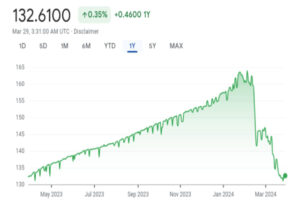It must be the SDR. The SDR (Special Drawing Rights) is a monetary policy tool that allows any IMF member country to print the USD, or any of the currencies that constitute the basket of SDR currencies. From 1999, this basket comprised of the U.S. dollar, the Euro, the British pound, and the Japanese yen. The Chinese yuan was admitted to this basket much later on October 1, 2016.
The IMF (International Monetary Fund) is the international financial institution responsible for maintaining the stability of the the global financial system. It achieves this objective by coordinating the monetary policies of member countries.
This major financial agency of the UN is headquartered in Washington DC. It is funded by 190 member countries which are also its shareholders. It is also the lender of last resort to national governments.
Allocation of SDRs
The SDR is IMF’s currency. It was created in 1969 to supplement shortfalls of preferred foreign exchange reserves of member countries. It is allocated to IMF member countries and it cannot be used by private entities or individuals.
The IMF has allocated SDRs only four times in its history. The first SDR allocations were done between 1970, and 1972, in response to the global shortage of U.S. dollars that followed the collapse of the Bretton Woods System.
The second set of allocations were done between 1979, and 1981, to address the global liquidity crisis that emanated from the financial turbulence that rocked the seventies decade.
This decade saw the collapse of the Bretton Woods System, rising global interest rates, a systemic global debt crisis, major oil price hikes, and supply disruptions caused by geopolitical tensions.
The third SDR allocations were done in 2009 to provide liquidity to the global economy in the aftermath of the 2007 – 2008 global subprime mortgage crisis.
The latest allocations were done in 2021 to provide liquidity to the global economy in response to the Covid-19 crisis. This allocation accounts for 69% of all SDRs ever distributed.
The value of the SDR is determined by a basket of currencies. The IMF determines the basket of SDR currencies by taking into account the importance of a country’s currency in international trade, and how freely, and widely, a currency is used in international trade.
Initially, the IMF allocated SDRs only to those countries whose currencies constituted the basket of SDR currencies. From 1974 to 1980, this basket consisted of as many as 16 currencies. In 1981, the basket was reduced to five major currencies. These were the U.S. dollar, the German mark, the French franc, the British pound, and the Japanese yen.
In 1999, the Euro replaced two currencies in the SDR basket, the German mark, and the French franc. The Chinese yen was added to the SDR basket in 2016.
Just before the covid-19 pandemic in 2019, many emerging economies were experiencing very serious foreign exchange rate volatility problems. Covid-19 helped to exacerbate this problem to crisis levels, and the IMF intervened to maintain the stability of the global financial system.
The IMF intervened by extending the allocation of SDR quotas to all of its 190 member countries. It allocated SDRs worth $650 billion on August 2, 2021. This is the largest allocation in its history. Kenya was allocated SDRs worth US$737.6 million.
The implication of this intervention is that any IMF member country, can now print any of the SDR basket currencies based on its SDR allocation. This intervention is supposed to help to address the foreign exchange rate volatility problem that is currently spiraling out of control in the world.
The IMF treats SDR draw downs by member countries as loans with no conditions, or obligation, and timeline to repay. However, a small amount of interest is payable to the IMF when a country draws down its SDR allocation. SDRs are therefore a cheap source of financing for IMF member countries.
How Countries Use Their SDR Allocations
Under the guidance of the IMF, member countries can increase their foreign exchange reserves by exchanging their SDR allocations for any of the SDR basket currencies, use them to repay loans, pay interest on loans, meet payment obligations, pledges or pay for increases in IMF quota amounts.
SDRs can therefore be used by countries for almost all budgetary needs. The use of SDR allocations by countries for any of the envisaged purposes triggers the printing of one, or more of the SDR basket currencies. This is true because SDRs have to be converted to one of the basket currencies to be used for transactions in global financial markets.
Money printing by countries happens when new money is introduced into the economy without being preceded by a productive process that ends in the increase of the quantity of goods, or provision of services.
In the case of the SDR, the IMF creates SDRs out of thin air, and allocates them to IMF member countries based on a country’s shareholding in the IMF. Countries can convert their SDRs to any of the SDR basket currencies, and use them in the global financial markets.
This type of transaction increases the supply of money without achieving a corresponding increase in the quantity of goods and services. The result is that more money begins to chase the same amount of goods and services causing prices to increase. This is how money printing causes inflation.
Why the Value of the KES Declined Rapidly
The value of the KES declined rapidly mainly because of the following three reasons:
- A moribund global monetary system
- Perennial budget deficits
- A negative balance of payments
1. A Moribund Global Monetary System
When faced with major financial crises, the IMF’s, and the major central banks preferred remedy, is to print money to throw at the problem rather than to fix what is wrong in the global economy.
To resolve the 2007 – 2008 subprime mortgage crisis, the Federal Reserve bank of the U.S. printed $4.5 trillion, and bailed out any troubled too big to fail U.S. corporation.
To resolve the sovereign debt crisis that plagued Europe in 2010, the European Central bank printed €1.1 trillion, and bailed out troubled financial institutions under its supervision.
The United Kingdom, which was also reeling from similar economic problems printed £445 billion, and bailed out troubled financial institutions in its jurisdiction. Japan and Sweden also printed money to address similar economic problems around this time.
To cushion the U.S. economy from the blow inflicted by covid-19, the U.S. government printed more than $5 trillion, and dished it out to households, mom-and-pop shops, restaurants, airlines, hospitals, local governments, schools, and other institutions around the country.
The printing of widely used currencies such as the U.S. dollar, the Euro, and the British pound increases the global supply of money. The printed money is easily exported to the rest of the world through international trade.
An increase in the global money supply causes global inflation because more money is added to the global economy to chase the same amount of goods and services.
Inflation can also be interpreted to mean the depreciation of government issued currencies. When the IMF, and the major central banks print money to resolve financial crises, the global money supply increases, and inflation follows.
The ever increasing of prices of goods and services is evidence that the value of KES has been declining together with the values of other global currencies over the years.
2. Perennial Budget Deficits
Kenya is one of those countries that do not balance their budgets. Each year, the national budget exceeds the tax revenue collected by the government. The expenditure that is beyond the tax revenue collected by the government is financed by borrowing from local, and international financial markets.
Borrowing by countries has to be maintained at sustainable levels to be beneficial to the borrowing country’s economy. To be beneficial and sustainable, a county’s debt should be below 30% of its GDP.
When a country’s debt goes beyond 30% of its GDP, that country begins to commit an increasing amount of resources towards debt repayment instead of development projects. Kenya’s debt as a percent of its GDP is above 70%. This means that Kenya is allocating a substantial amount of its tax revenue towards debt repayment instead of development projects.
Since most of Kenya’s debt is foreign debt, Kenya has to buy substantial amounts of foreign currency to repay its foreign debts. This transaction depletes Kenya’s foreign currency reserves, retards economic growth, and depreciates the KES.
3. Negative Balance of Payments
A negative balance of payments occurs when a country’s imports exceed her exports. This is not good for a country because paying for more imports drains a country’s foreign exchange reserves, and selling less exports does not replenish them. Countries with declining foreign exchange reserves experience a depreciation of their currencies.
A negative balance of payments is largely caused by an aggressive tax code. An aggressive tax code is one that burdens business enterprises and individuals with excessive taxation. Excessive taxation increases the cost of doing business, reduces business capital, and the profitability of business ventures.
The goods and services produced in a country with an aggressive tax code are expensive compared to the ones produced in a country with a non aggressive tax code. A non aggressive tax code is one that does not negatively impact the cost of doing business, and leaves most of business profits available for reinvestment.
Kenya has an aggressive tax code. The cost of doing business in Kenya is very high. Business profits, income, and consumption are taxed aggressively. Electricity and fuel, which constitute a significant proportion of the cost of producing goods and services are taxed heavily.
Manufacturing and processing, spare parts, agricultural inputs, and implements such as tractor ploughs attract steep taxes from the government. The goods and services produced under such a heavy taxation regime are expensive. They cannot compete favorably in international markets with the goods and services produced in countries with business friendly tax codes.
An aggressive tax code is what caused Kenya’s imports to exceed her exports. It is largely responsible for pricing the country’s goods and services out of international markets, and causing the value of the KES to decline.
How Kenya Can Strengthen the KES
From the foregoing, a moribund global monetary system, perennial budget deficits, and a negative balance of payments are the main causes of the persistent weakening of the KES.
There is nothing Kenya can do about the moribund nature of the global monetary system. Kenya’s meagre shareholding in the IMF, and its lack of influence on the major central banks, exposes the KES to the whims of the monetary policy decisions of the IMF, and the major central banks. The KES will continue to decline with other global currencies in this respect.
Perennial budget deficits are self inflicted injuries to the country’s finances. These injuries are inflicted on the country’s finances every year during the preparation of the national budget.
Kenya’s politicians and policymakers can prevent the country from drowning in unsustainable debt by tapering their grand development ideas, and preparing a balanced budget. The reduction, or absence of the pressure of foreign debt repayment on the country’s finances will strengthen the KES.
An aggressive tax code is another self inflicted injury on the country’s finances. Kenya is an independent country, it can reform its tax code to make it business friendly, and progressive for economic growth.
Aggressive levels of taxation can be reduced, and unreasonable layers of taxation can be removed to reduce the cost of doing business, and increase the profitability of business ventures in the country.
Progressive tax reforms will reduce the cost of producing goods and services in the country, and make them competitive in international markets. If the tax reforms are done properly, exports will exceed imports, and foreign exchange reserves will increase. The increasing foreign exchange reserves will strengthen the KES.
How the KES Was Fixed
Nothing was fixed in the country but KES strengthened. The SDR is the magic wand that was waved by the government, and the KES strengthened.
As per IMF guidelines, countries can use their SDR allocations to increase their foreign exchange reserves, repay loans, pay interest on loans, meet payment obligations, pledges, or pay for increases in IMF quota amounts.
Of the three main causes of the decline of the KES, Kenya does not have control of the moribund nature of the global monetary system, but it can correct budget deficits, and negative balance of payments.
We know that there has been no effort to correct the negative balance of payments problem because tax reforms have not been done. Budget deficits did not decrease, but the consequences of running huge budget deficits such as defaulting on debt repayments, and other payment obligations melted away.
This is what must have happened. The government drew down some of its SDR allocation and used it to increase the country’s foreign exchange reserves, repay the principal and interest on eurobonds, and meet other urgent payment obligations.
Drawing down the SDR allocation for these purposes helped to inject US dollar liquidity into the country’s economy and lead to the strengthening of the KES.
The Outlook For the KES
The lack of initiative by the government to reduce the country’s budget deficit, and correct the negative balance of payments problem, leaves the fate of the KES in the hands of the IMF. As long as this status quo remains, the value of the KES will keep declining. It will only deviate from this trajectory when the IMF intervenes.
The world has entered the inflationary phase of the economic cycle. It is increasingly becoming difficult for investors to retain value in government issued currencies, and financial investments. In such times, it is prudent to invest your liquid wealth into real assets to preserve value.
Precious metals, especially gold, are very good at retaining value during inflationary phases of the economic cycle.






